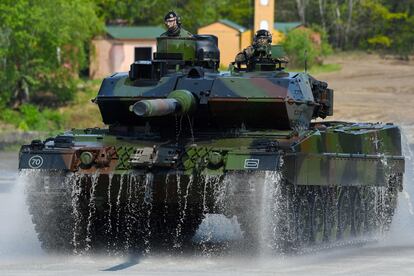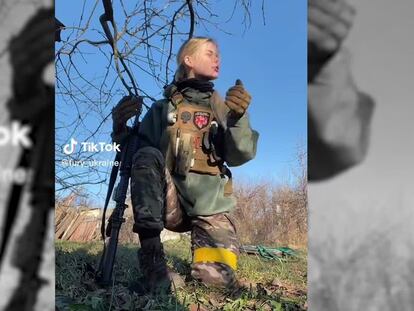Tank delivery opens up new phase in West’s military support for Ukraine
The supply of Leopard 2s and Abrams, until now considered a red line, could pave the way for the future transfer of further equipment such as fighter jets

In the end, the tanks were not the red line. After weeks of negotiations and extensive debates, Ukraine will receive the long-awaited German-made Leopard 2 battle tanks as well as US Abrams. This pledge by Western countries, which have acted together, marks a new phase in Western support for Kyiv. It is a far-reaching political gesture that keeps alive the ongoing support for Ukrainian troops. But the Leopard 2 and the Abrams – which some were reluctant to deliver, fearing Moscow’s reaction to this escalation – will only truly mark a turning point in the battle if they come with sufficient technical support and a logistics structure, said diplomatic sources. Some analysts and experts are now wondering whether the next phase of Western support will be to supply fighter jets to Kyiv – whether that is another red line to be crossed in due course.
Until now, Kyiv’s allies had mainly provided Soviet-era weapons. But some taboos were broken when Western countries started delivering Javelin anti-tank missiles – which arrived last winter and have been decisive in the battle – as well as Stingers, howitzers, Himars rocket launchers, Patriot missile systems and armored fighting vehicles. A list to which modern battle tanks are now being added.
NATO and Western intelligence services warn that there is data to support that Russia is preparing a spring offensive. And allied military support for Ukraine will increase, says defense analyst Frédéric Mauro, a research associate at the Institut de Relations Internationales et Stratégiques in Paris. “A decision has been made to help Ukraine and it must be done until victory is achieved. Until it wins the war. There is no other option, it cannot be done any other way,” said Mauro, who is convinced that the next step for the allied countries will be to send planes to Kyiv, followed by cruise missiles. “From no point of view is it possible to let the Russian aggression go unpunished.”

For some analysts, the idea of putting German-made Leopard 2s and American Abrams on Ukrainian soil is almost more important than the crucial significance of these tanks in battle. It is, Mauro says, “an evolution.” They will provide an element of differentiation: greater mobility, protection, firepower, sophisticated military elements such as night vision and thermal cameras. But these Western tanks are, above all, the great missing piece among the weapons that the allied countries have sent so far. Still, their use must be coordinated with all the rest of the military equipment. “Logistics and the support chain is what really makes the difference,” says Mauro.
The idea is for Germany and its allies to supply 112 Leopard 2s, and also for Berlin (which will initially deliver about 14; the rest will arrive from Finland, Norway, Poland and Spain for the time being) to undertake the training of Ukrainian soldiers in the management of these tanks, logistics, ammunition and maintenance. “We are acting in a closely coordinated manner internationally,” said the German Chancellor, Olaf Scholz. On Wednesday, US President Joe Biden, spoke by telephone with the German leader and with his counterparts Emmanuel Macron of France, Giorgia Meloni of Italy and Rishi Sunak of the United Kingdom.
The decision by Germany and the US to send heavy battle tanks to Ukraine, which will add to the delivery of 14 Challenger 2 tanks by the United Kingdom, comes shortly after Ukraine’s other partners, led by Estonia, announced large packages of military aid, the largest since the start of the invasion. And in another paradigm shift, Switzerland, a traditionally neutral country, has taken a crucial first step to allow other countries to re-export Swiss-made weapons to Ukraine by passing a motion to that effect in one of its parliamentary committees.
The gesture also seeks to cover up the differences that had arisen between the allies, made visible at the summit last week in Ramstein (Germany) and after weeks of public debate, with Berlin under the spotlight and strong pressure from Poland and the Baltic countries against a backdrop of increasingly bloody fighting in eastern Ukraine.
The Secretary General of NATO, Jens Stoltenberg, said on Wednesday that he enthusiastically welcomes the decision. “At a critical moment in Russia’s war, these can help Ukraine to defend itself, win and prevail as an independent nation,” he tweeted. “Together we are stronger,” stressed Polish Prime Minister Mateusz Morawiecki, who had harshly criticized Berlin in recent days for stalling on the decision.
The tanks and their technical structure will take weeks – even months – to reach Ukraine. Meanwhile, the government of Volodymyr Zelenskiy already has its eyes on the expected spring offensive by Russia. The goal is to try to regain ground before the Kremlin intensifies its attacks with another wave of better-trained recruits than Moscow sent to the front in late autumn.
Intelligence sources also indicate that the Russian president is likely to use his air force to a greater extent. Until now, aviation has not been a noteworthy variable in Russia’s war in Ukraine. And with this element in mind, Ukrainian requests for shipments of anti-aircraft batteries are increasing. Some Ukrainian government officials have also started slipping in a request for jet fighters.
On the economic front, one year after the large-scale invasion launched by Russian President Vladimir Putin, financial support for Ukraine has also entered a new phase. Next week, the leaders of EU institutions plan to hold a summit in Ukraine, and the European Commission will hold a meeting of its college of commissioners. These gatherings will send a very powerful message to the Kremlin about Ukraine’s future accession to the EU. Meanwhile, Poland and the Baltic states have once again called for Ukraine’s express accession to NATO and have requested a visit by Stoltenberg to Ukraine as a gesture of goodwill. This request, however, has been met with silence.
Sign up for our weekly newsletter to get more English-language news coverage from EL PAÍS USA Edition
Tu suscripción se está usando en otro dispositivo
¿Quieres añadir otro usuario a tu suscripción?
Si continúas leyendo en este dispositivo, no se podrá leer en el otro.
FlechaTu suscripción se está usando en otro dispositivo y solo puedes acceder a EL PAÍS desde un dispositivo a la vez.
Si quieres compartir tu cuenta, cambia tu suscripción a la modalidad Premium, así podrás añadir otro usuario. Cada uno accederá con su propia cuenta de email, lo que os permitirá personalizar vuestra experiencia en EL PAÍS.
¿Tienes una suscripción de empresa? Accede aquí para contratar más cuentas.
En el caso de no saber quién está usando tu cuenta, te recomendamos cambiar tu contraseña aquí.
Si decides continuar compartiendo tu cuenta, este mensaje se mostrará en tu dispositivo y en el de la otra persona que está usando tu cuenta de forma indefinida, afectando a tu experiencia de lectura. Puedes consultar aquí los términos y condiciones de la suscripción digital.
More information
Archived In
Últimas noticias
There is as much life left to discover on planet Earth as that which is already known
Dozens presumed dead, around 100 injured in fire at Swiss Alps bar during New Year’s celebration
Is porn for women different from conventional porn? We spoke to those who make it
Cartagena de Indias is sinking: What can the city do to mitigate it?
Most viewed
- Reinhard Genzel, Nobel laureate in physics: ‘One-minute videos will never give you the truth’
- Sinaloa Cartel war is taking its toll on Los Chapitos
- David King, chemist: ‘There are scientists studying how to cool the planet; nobody should stop these experiments from happening’
- Oona Chaplin: ‘I told James Cameron that I was living in a treehouse and starting a permaculture project with a friend’
- The Interoceanic Train, the Mexican alternative to the Panama Canal











































